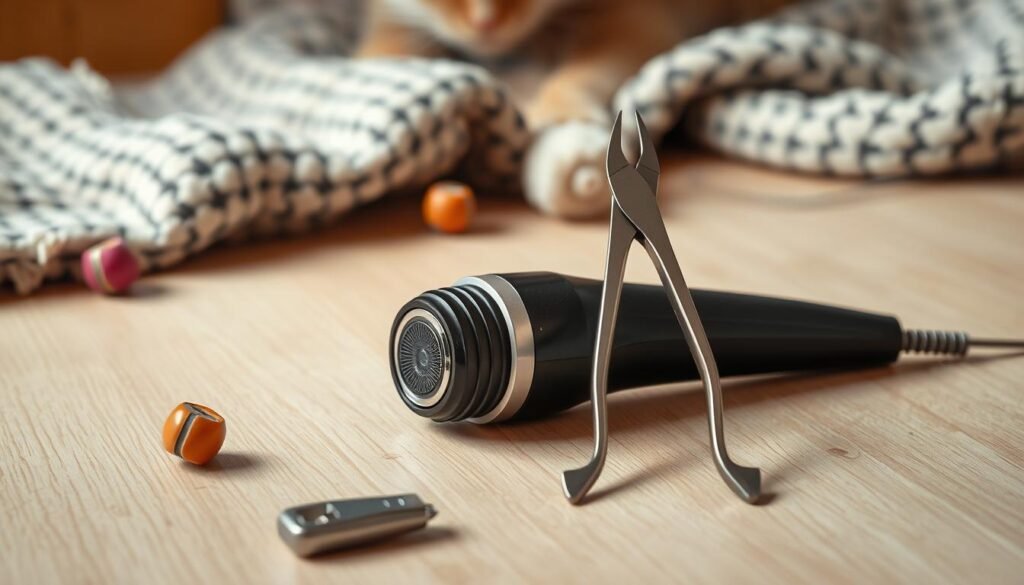Are you nervous about cutting your cat’s nails? Many cat owners find it scary, but it’s very important. Learning how to cut cat nails can prevent scratched furniture and keep your pet safe and happy.
Feline nail clipping takes patience and practice. With the right tools and techniques, it can be easy for you and your cat. Trimming every 2-3 weeks keeps your cat’s paws healthy and saves your furniture.
Unlike declawing, which can cause problems, nail trimming is safe and kind. By learning to trim your cat’s nails, you’re showing you care about their well-being.
Key Takeaways
- Regular cat nail trimming promotes feline health and home protection
- Trimming is a safe alternative to declawing
- Aim to trim your cat’s nails every 2-3 weeks
- Various tools are available for feline nail clipping
- Patience and practice are key to successful cat paw care
Understanding the Importance of Regular Nail Trimming
Trimming your cat’s nails is key for their comfort and safety. It also keeps your home safe from damage. Let’s see why it’s vital for their health.
Health benefits for your cat
Keeping your cat’s nails short prevents many problems. Long claws can hurt their joints and change how they walk. Trimming helps them move naturally and avoids getting their nails stuck.
Protecting your furniture and family
Short nails mean less damage to your furniture and fewer scratches on people. It makes your home safer for everyone. Your cat can still scratch naturally without harming things.
Frequency of nail trimming
How often you trim your cat’s nails depends on their life and age. Here’s a simple guide:
| Cat Type | Trimming Frequency |
|---|---|
| Indoor cats | Every 2-3 weeks |
| Kittens | Weekly |
| Older cats | Monthly |
| Outdoor cats | Few times a year |
Look for signs your cat’s nails need a trim, like not retracting or being very curved. Regular grooming keeps their nails healthy and strengthens your bond.
Essential Tools for Cat Nail Trimming

Trimming your cat’s nails needs the right tools. Let’s look at the various grooming tools for cats. They make the task easier and safer for you and your cat.
Types of Nail Clippers and Grinders
Cat nail clippers come in different styles. Each has its own benefits:
- Scissors-style clippers: Easy to handle and precise
- Guillotine-style clippers: Offer a clean cut for thicker nails
- Pliers-style clippers: Provide extra leverage for tough nails
- Cat nail grinders: Gently file down nails without sharp edges
Choose the tool that feels most comfortable. It should match your cat’s needs. Some cats like the quick snip of clippers. Others prefer the gentle vibration of a grinder.
Additional Supplies to Have on Hand
Along with clippers or a grinder, get these items for a smooth session:
| Item | Purpose |
|---|---|
| Cat treats | Reward and distract your cat |
| Styptic powder | Stop bleeding if you cut too close to the quick |
| Towel | Wrap your cat for better control if needed |
| Pheromone spray | Create a calming environment |
With these tools, you’ll be ready to trim your cat’s nails with confidence. Remember, patience and practice are key. They help you master this important pet care skill.
Preparing Your Cat for Nail Trimming
Preparing for a cat pedicure is important. It starts with setting up the right space and getting your cat used to the process.
Find a quiet spot in your home for grooming. This reduces distractions and keeps your cat calm. Sit comfortably with your cat, either on your lap or on a flat surface.
For cats that move a lot, try the “purrito” method:
- Wrap your cat in a towel like a burrito
- Leave one paw exposed at a time
- This restricts movement and keeps your cat secure
Begin grooming routines early if you can. Kittens are more open to new things. Massage their paws often to help them get used to touch. This builds trust and makes nail trims easier.
| Preparation Step | Purpose |
|---|---|
| Choose quiet area | Reduce distractions |
| Find comfortable position | Ensure stability during trimming |
| Use “purrito” method if needed | Control movement of nervous cats |
| Start young | Build positive associations early |
| Regular paw massages | Accustom cat to touch |
Practice touching your cat’s nails without cutting them. This gets them used to the feeling. With patience and regular practice, your cat will learn to accept this grooming.
How to Cut Cat Nails: Step-by-Step Guide
Learning to trim your cat’s nails is key for their health and your home. This guide will show you how to do it safely and well.
Finding the Right Position
First, find a comfy spot for your cat. Some like sitting on your lap, others on a table. Make sure it’s well-lit so you can see the nails.
Isolating the Nail and Identifying the Quick
Press your cat’s paw to extend the nail. Look for the pink part, the quick, which has blood vessels. Cut only the white part to avoid pain or bleeding.
Proper Cutting Technique
Use sharp clippers to trim the nail at a 45-degree angle. Start with small cuts and gradually get longer as you get better. Regular use of a cat scratching post helps keep nails healthy.
Dealing with Difficult Cats
For restless cats, wrap them in a towel or do it in short sessions. Give treats to make nail trimming positive. If they get too stressed, stop and try again later. With patience, you’ll learn to trim their nails safely.
FAQ
Why is it important to trim my cat’s nails regularly?
How often should I trim my cat’s nails?
What tools do I need for cat nail trimming?
How do I prepare my cat for nail trimming?
How do I properly cut my cat’s nails?
What should I do if my cat is difficult during nail trimming?
Source Links
- How to trim cat claws – https://www.humanesociety.org/resources/trimming-cats-claws
- How to Trim Cat Nails: Step-by-Step Tips From a Professional Groomer – https://be.chewy.com/pro-tips-for-cutting-cat-nails-a-step-by-step-guide/
- Cat Nail Trimming 101 | Wisconsin Humane Society – https://www.wihumane.org/behavior/ask-the-experts/cat-behavior/cat-nail-trimming-101








Great article, but arent declawing cats a simpler solution? This nail trimming seems like unnecessary fuss. What do you think, guys?
Interesting guide, but isnt declawing a more permanent solution? Less hassle for owners and furniture. What are your thoughts?
Nice guide but honestly, isnt letting a cats nails grow naturally a part of its wild instincts? Just food for thought.
Good points, but anyone else think its weird were not talking about declawing? Seems like the ultimate furniture saver to me.
Why trim cat nails when scratching posts exist? Isnt it natural for cats to maintain their own claws? Seems like unnecessary stress for them.
Scratching posts dont prevent injury or furniture damage. Trimming is responsible pet ownership.
Interesting article, but isnt declawing just a more permanent solution? Why are we so against it? Lets discuss that aspect too!
I get the health benefits, but isnt declawing much easier? Saves the furniture and no more scratches for us! Thoughts?
Declawing is inhumane! Better to train your cat than mutilate it for convenience.
Interesting read, but whos to say cats dont enjoy their nails long? Maybe its more natural for them? Just food for thought.
I appreciate the guide, but isnt declawing a simpler solution? Why stress cats with regular nail trimming? Just a random thought.
Interesting read, but isnt declawing easier? Saves the furniture, too. Yes, Ive heard its controversial, but isnt it an option? Just thinking out loud.
Interesting read, but is it really necessary to trim their nails? I mean wild cats manage without pedicures, dont they?
Wild cats climb trees and hunt, wearing their nails down. Your house cat doesnt. Trim them!